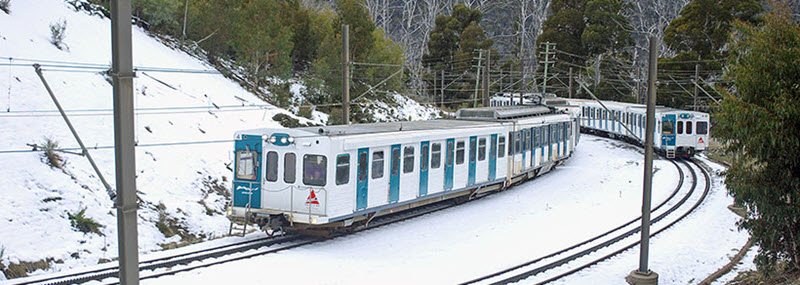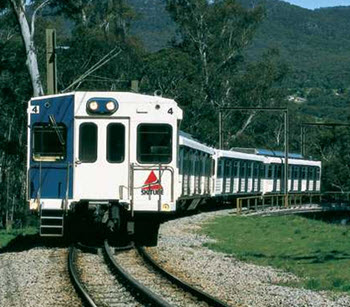
The Skitube Alpine Railways is a 8.5 km long single-track standard gauge electric railway running from Alpine Way at Bullocks Flat to Blue Cow, through the Kosciuszko National Park in New South Wales, Australia. It is a popular train among skiiers wishing to reach the ski resorts and snowfields of the Blue Cow Mountain and Perisher Valley.
During its journey from Alpine Way at Bullocks Flat and the ski resorts of Perisher Valley and Blue Cow Mountain, the train passes through two tunnels: The Bilson Tunnel and the Blue Cow Tunnel.
The Skitube Alpine Railway only have three stations, and two of them are underground.
In 2016-2017, Stadler Rail carried out a major upgrade of the Skitube Alpine Railways.
Short facts about the Skitube Alpine Railway
- The railway has two electrical substations which are fed with 33 kV power, and ouput 1.5 kV DC for the overhead wiring.
- The track gauge is 1,435 mm
- The dept of the tunnels varies from 4 meters to 550 meters.
- The diametre of the tunnels varies from 5 meters to 5.5 metres.
- Passing loops are used to help the train climb the mountain. Maximum incline is 12.5%.
- The rack system operates on the Lamella System, a system developed by the Von Roll company.
- The railway is Swiss designed.
- A consortium of Swiss and Australian companies provided the rolling stock, overhead wiring, sub-stations, communications and signalling.
- The train is capable of doing 40 km/h, but when it goes downhill the speed is limited to 21 km/h for safety reasons.
The journey
 At the railway’s starting point in Bullocks Flats, there is a big parking facility for 3,500 cars and 250 coaches. This is also where you find the ticket shop, information desk, pass office, etc. You can hire ski and snowboard equipment here and enroll in the ski and snowboarding school.
At the railway’s starting point in Bullocks Flats, there is a big parking facility for 3,500 cars and 250 coaches. This is also where you find the ticket shop, information desk, pass office, etc. You can hire ski and snowboard equipment here and enroll in the ski and snowboarding school.
When you enter the train, you are 1,125 metres above sea level. The railway runs above ground for 2,6 km and crosses a three span 150 metre long steel truss bridge. After the passing loop, the train will enter a tunnel and climb on a 12.5% gradient to get to the Perisher Valley terminal.
After the Perisher Valley terminal, the line drops downgrade for a while, before climbing on a 3% gradient for 1.3 kilometres. Near the terminus, it will climb at 12,5%.
When you reach the Mount Blue Cow station, you are 1,905 metres above sea level.
The trip from Bullocks Flats to Perisher Valley takes about 10 minutes. It then takes a further 7 minutes to get to Blue Cow.
Rolling stock
The Alpine Skitube Railway has 11 carriages built by Comeng, Granville in New South Wales. Each carriage is 16.8 m long and 3.8 m wide. Maximum capacity is 225 passengers per carriage.
The four motor cars each have four 301 kW traction motors. There are also four driving trailers and three non-driving trailers.
The breaking system for the Alpine Skitube Railway is mixed regenerative and rheostatic.
Freight
Initially, two four-wheel ‘S’ open wagons were purchased from the State Rail Authority and cut down to flat wagons to provide room for goods. These have now been replaced by a bogie NVMF wagon.
Lokomotive
1958 Tulloch Limited built locomotive
Seasons
The peak season for the Skitube Alpine Railway is July – September.
An off-peak schedule is run from early to late June, and then again from mid to late September.
History
Background
As the Thredbo and Perish Valley skifields became increasinly popular amoung winter tourists in the 1980s, the mountain road leading up to them suffered from congestion and there was also a lack of suitable parking. Building wider roads and adding large carparks would have been unsuitable from an environmental point of view, instead, various other solutions were investigated – such as chairlift, aerial gondola, funicular railway and standard gauge railway.
A rack and pinion standard gauge railway was found to be the best option, if it could run mostly underground. Such a railway would be weather resilient and have a large capacity, and it wouldn’t scar the mountainsides much.
Construction of the railway
The Perisher Skitube Joint Venture was formed to carry out the railway project. Transfield and Kumagai Gumi each owned 49% of the shares, with Canberra engineer Ken Bilston holding the remaining 2%. Ken Bilston was the project’s technical manager.
Feasibility studies commenced in 1982, and construction started in October 1984. The tunnelling part of the project began in June 1985.
- The Bilson Tunnel (which is 3.3 km long) was constructed using a 5.5-metre tunnel boring machine.
- The Blue Cow Tunnel (which is 2.6 km long) was construction using the traditional drill-and-blast method.
30 kg/m second-hand rail from the State Rail Authority was used to build the line.
On 26 July 1987, the 5.9 km section between Bullocks Flat and Perisher opened for traffick. On 31 March the following year, the entire 8.5 km line – all the way to Blue Cow – premieered.
